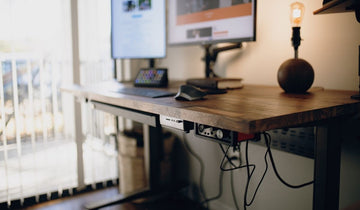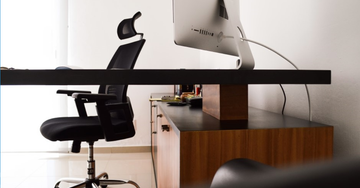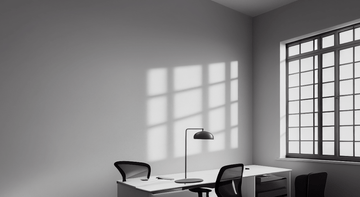Should I Buy a Standing Desk: Pros, Cons, and Best Practices
by Khent Barangas on Oct 20, 2025

Sitting is the new smoking.
Studies show that people who spend more than eight hours a day sitting without exercise face health risks similar to those caused by obesity and smoking. Findings like this sparked a new workplace trend: the standing desk.
The idea is simple. Stand more, sit less, and you’ll avoid the problems that come with hours of sitting.
But is simply swapping one static posture for another really the answer to a sedentary lifestyle?
Just like any workplace wellness trend, the standing desk comes with both benefits and drawbacks. In this guide, we’ll break down the complete standing desk pros and cons, drawing on research to help you decide whether to get a standing desk in your workspace.
What is a Standing Desk Anyway?

A standing desk, sometimes called a stand-up desk or sit-stand desk, is designed to let you work while standing instead of sitting in a chair. Many modern models are height-adjustable, so you can switch between sitting and standing throughout the day.
While standing desks can be custom-built or purchased as fully adjustable setups, not everyone chooses that route. Some people use alternatives like computer risers. These are platforms placed on top of a regular desk to raise a monitor or laptop.
Although a riser isn’t the same as a full standing desk, it creates a similar effect by allowing you to work in a standing position.
This idea, however, isn’t entirely new. Historical figures like Ernest Hemingway and Leonardo da Vinci were known to work while standing.
Today, the standing desk has become a modern workplace trend, fueled by research linking long hours of sitting to health risks.
Why People Are Standing Up: 5 Advantages of Using a Standing Desk

Using a standing desk offers more than just a change in posture. Here are the main benefits of using a standing desk backed by research and user experience.
1. Helps You Sit Less and Move More
Most of us don’t realize just how long we stay seated. Hours can pass without standing up, especially in desk-heavy jobs. As mentioned, this sedentary lifestyle can result in serious health risks.
This is one of the clearest benefits of using a standing desk. In one study, employees who used sit-stand desks reduced their sitting time at work by 143 minutes or nearly 2.5 hours per day within the first week. Even after three months, they were still sitting for more than two hours less compared to their coworkers who stayed seated.
That may not seem like a huge change, but two hours less sitting per day equals ten fewer hours every workweek. Over a year, that’s hundreds of hours your body spends upright instead of slouched in a chair.
Here’s what makes that interesting: the time spent sitting was almost entirely replaced with standing, not walking. Yet, researchers found a positive impact on health markers, including an increase in “good” HDL cholesterol.
2. Improved Posture and Reduced Muscle Fatigue
One of the quickest benefits of using a standing desk is better posture. Hours of leaning toward a screen often lead to forward head posture, which strains the neck, shoulders, and upper back.
Studies show that even standing for just 30 minutes can make a difference. By encouraging a more natural alignment, standing desks reduce muscle tension and provide almost immediate relief.
Office workers reported less neck and shoulder fatigue after short standing periods. This suggests that alternating between sitting and standing can prevent discomfort from building up over the day.
3. Can Ease Back Pain
Back pain is one of the most common complaints among office workers. Sitting for long hours compresses the spine, tightens the hips, and weakens core muscles—all of which contribute to chronic discomfort.
A recent study followed office workers for six months and found that those using sit-stand desks, combined with motivational prompts and light guidance, reported less musculoskeletal discomfort compared to employees who stayed seated all day.
Not only did workers experience less pain in regions like the lower back, but they also reported lower levels of post-work fatigue. That means they ended the day with more energy instead of feeling drained.
4. Keeps Energy Levels Steady
We’ve all experienced that mid-afternoon slump. Your shoulders droop, focus fades, and your body feels heavy in the chair. Using a standing desk can help break this cycle.
A study found that using a sit-stand desk actually slowed down the usual rise in fatigue and sleepiness during the workday. Alternating between sitting and standing helped workers stay more alert and energized throughout the day instead of hitting that mid-afternoon crash.
One reason for this is our blood flow. When we stand, blood flows more freely and muscles stay engaged. That gentle movement keeps the body awake, which can translate to a sharper mind.
5. Can Make You More Productive
This can be surprising for some people, but using a standing desk can actually boost productivity. Many assume standing would be distracting during work, but studies suggest otherwise.
In one study, employees using standing desks were 46% more productive than those who sat all day. What’s interesting about this study is that during the first month, there was no noticeable difference between the two groups.
But by the second month, productivity began to rise among the stand-capable group as they became more accustomed to their new workstations.
The study also revealed that almost 75% of employees using standing desks reported less body discomfort. Researchers believe this reduction in physical strain may be what allowed workers to stay more focused and engaged throughout the day.
3 Drawbacks of Standing Workstations

Many people assume more standing is always better, but that’s not the full picture. Here are some of the disadvantages of using a standing desk.
1. Can Lead to Leg and Foot Discomfort
One common drawback of standing desks is discomfort from prolonged use. Spending too much time on your feet can lead to leg fatigue, sore feet, and even increase the risk of varicose veins.
This happens because standing still puts extra pressure on the lower body. Without supportive footwear or an anti-fatigue mat, that pressure adds up quickly.
According to the Canadian Centre for Occupational Health and Safety (CCOHS), extended standing reduces blood supply to the muscles. This makes fatigue and discomfort almost unavoidable if you do not take breaks.
2. Possible Negative Impact on Focus
Didn’t we just say standing desks can improve productivity? Yes, and research backs that up. But the effect isn’t universal.
For tasks that require fine motor skills, precision, or long stretches of focus, standing can sometimes make things more difficult.
According to a Harvard article, “standing all day” can reduce efficiency or comfort in some tasks, especially when you haven’t yet adapted.
3. Higher Cost
Getting a high-quality sit-stand workstation (or adjustable desk) with good engineering, a stable frame, and ergonomic adjustment isn’t cheap. Most people aren’t shocked by this, but it’s still worth pointing out.
And the desk itself may not be the only expense. For comfort, you might also need extras like a supportive footrest or an anti-fatigue mat. This adds even more to the total price. Yikes!
Best Practices: How to Use a Standing Desk the Right Way

Many of the drawbacks of standing desks do not come from the desks themselves, but from the way people use them. The most common mistake is trading eight hours of sitting for eight hours of standing.
The real benefit of a sit-stand desk comes from movement and variation, not from locking into one position.
Here are some tips to help you maximize the benefits while avoiding the drawbacks:
1. Try the 20-8-2 Rule
The 20-8-2 rule is the most popular and well-regarded protocol. This goes like this:
-
Sit for a maximum of 20 minutes.
-
Stand for 8 minutes.
-
Move/Stretch for 2 minutes (e.g., walk to the water cooler, do a quick stretch).
This cycle repeats every 30 minutes, encouraging people to break up sedentary time without overdoing the standing part.
2. Gradual Adoption
If you are new to standing, start with 30 minutes of standing per day and slowly increase your time over several weeks as your muscles adapt. Never stand for more than 60 minutes at a time without a break.
3. Don’t Forget the Standing Ergonomics
Incorrect posture while standing is just as detrimental as slouching while sitting. Follow these non-negotiable rules for your setup:
- Ellbow Angle: Your desk height should allow your forearms to be parallel to the floor, with your elbows bent at a comfortable 90° to 100° angle.
- Monitor Height: The top of your computer monitor should be positioned at or slightly below eye level. You should not have to crane your neck up or down to view the screen.
- Foot Positioning: Avoid locking your knees. Shift your weight frequently, or use a foot rail or footrest to alternate resting one foot slightly higher than the other
4. Use supportive accessories
Never stand directly on a hard floor for prolonged periods. Get a high-quality anti-fatigue mat, footrest, or supportive shoes to support your legs and lower back. These are essential to cushion your feet, reduce pressure on your joints, and encourage subtle micro-movements.
5. Incorporate Movement and Micro-Breaks
Even the perfect standing posture is still static. To truly minimize blood pooling and fatigue, keep moving.
Use your two-minute break to do simple exercises like calf raises, neck rolls, or marching in place to promote blood flow back to the heart.
6. Listen to Your Body
Pain is your body’s signal that you have exceeded your current standing capacity. If you feel lower back pain or leg soreness, immediately switch back to sitting.
Create Your Own Standing Workstation
Now that we’ve gone through the benefits, drawbacks, and best practices, you might be thinking about setting up your own standing workstation. The good news is, you do not need a full office makeover to get started.
With these 2 essentials from Qoncept living, you can create a setup that works for you:
1. Ascend Electric Height Adjustable Desk

To start, you will need a dependable desk. The Ascend Electric Height Adjustable Desk offers a sturdy frame, smooth motorized lift, and up to 80 kg weight support.
Its standout feature is the self-leveling function, which keeps the desk stable even on uneven floors. With the LED memory control panel, you can save your preferred heights and switch from sitting to standing in seconds.
2. Elevate Table Riser

If you are not ready for a full desk replacement, a laptop riser can be a simple and practical solution. One great option is the Elevate Sit and Stand Table Riser.
With a one-press adjustable switch, it smoothly raises your laptop to a comfortable height.
It helps lift your screen to the right height, reducing strain on your neck and shoulders while allowing you to work comfortably, whether seated or standing.
Frequently Asked Questions
Will a Standing Desk help me lose significant weight?
No. Not on its own. While standing does burn more calories than sitting, the difference is minimal and will not lead to significant weight loss without other changes.
A meta-analysis of 46 studies found that standing burns approximately 0.15 more calories per minute than sitting. For a 143-pound person standing for six hours a day, this translates to an extra 54 calories burned, roughly the same as half an apple.
Does standing at my desk prevent heart disease?
No. Static standing is not a substitute for aerobic exercise.
This is a major misconception. Studies have found that static standing (standing still at a desk) does not significantly improve cardiovascular health and may even increase certain risks.
Should I stand all day at a standing desk?
Definitely not. Replacing eight hours of sitting with eight hours of standing is just swapping one static posture for another. Prolonged standing can cause leg fatigue, sore feet, lower back strain, and even circulatory issues.
Do standing desks help with back pain?
Yes. Research shows that standing desks can help reduce musculoskeletal discomfort when used properly. The key is balance; alternate between sitting and standing.
Is it worth buying a standing desk?
Yes. If you spend long hours working at a desk, a sit-stand option is a worthwhile investment. It encourages better posture, reduces fatigue, and supports overall comfort throughout the day.









